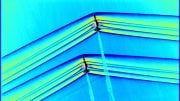
Nagoya University researchers successfully simulated clear-air turbulence around Tokyo using Japan’s Fugaku supercomputer, gaining insights into the causes of turbulence and potentially improving aviation safety.
A research group from Nagoya University utilized Japan’s Fugaku supercomputer to simulate clear-air turbulence around Tokyo, improving upon current predictive models. The study, published in the journal Geophysical Research Letters, identified the collapse of the Kelvin-Helmholtz instability wave as a primary cause of turbulence. By validating their simulations against real-world observational data, the researchers hope to enhance the understanding of turbulence generation and its impact on aircraft, potentially improving flight safety.
Accurate Simulation of Air Turbulence Using Supercomputers
A team of researchers from Nagoya University has successfully used Japan’s fastest supercomputer to accurately simulate clear-air turbulence around Tokyo. They then cross-referenced their findings with actual flight data to enhance the accuracy of their predictive model. The research was published in the journal Geophysical Research Letters.
Understanding Clear Air Turbulence (CAT)
Although air turbulence is typically associated with bad weather, an airplane cabin can shake violently even on a sunny and cloudless day. Known as clear air turbulence (CAT), these turbulent air movements can occur in the absence of any visible clouds or other atmospheric disturbances. Although the exact mechanisms that cause CAT are not fully understood, it is believed to be primarily driven by wind shear and atmospheric instability.
CAT is a significant threat to aviation safety. Unanticipated turbulence on an otherwise tranquil day can lead to injuries among passengers and crew members, damage aircraft, and disrupt flight operations. Pilots use data from other aircraft, weather radar, and atmospheric models to anticipate and avoid turbulence. However, forecasting CAT is particularly challenging since it doesn’t present visible indicators such as clouds or storms.
Large-Eddy Simulation (LES) and the Challenge of Computing Power
The creation of eddies, or swirling winds that lead to sudden changes in airflow, can shake an aircraft. As such, scientists rely on large-eddy simulation (LES), a computational fluid dynamics technique, to model turbulent flows and better understand CAT. However, one of the main challenges of LES is the substantial computational power required to simulate these intricate interactions.
To overcome this hurdle, the Nagoya University research team used an exascale computing system known as the Fugaku supercomputer to elaborately simulate the process of turbulence generation using high-resolution LES. Located at the Riken Center for Computational Science in Kobe, Japan, Fugaku is a high-performance computing system that is currently ranked as the world’s second-fastest supercomputer.
Uncovering Turbulence Patterns Over Tokyo
Leveraging Fugaku’s tremendous computational power, Dr. Ryoichi Yoshimura of Nagoya University and his colleagues, including Dr. Junshi Ito at Tohoku University, conducted an ultra-high-resolution simulation of winter CAT above Tokyo’s Haneda airport, triggered by low pressure and a nearby mountain range.
They discovered that the disturbance in wind speed was due to the collapse of the Kelvin-Helmholtz instability wave. This type of instability arises at the interface between two layers of air with differing velocities, creating wave-like effects and several fine vortices that cause turbulence.
Validation and Implications of the Research
After conducting their calculations, the team validated their simulated vortices against real-world data. “Around Tokyo, there is a lot of observational data available to validate our results,” said Yoshimura. “There are many airplanes flying over the airports, which results in many reports of turbulence and the intensity of shaking. Atmospheric observations by a balloon near Tokyo were also used. The shaking data recorded at that time was used to show that the calculations were valid.”
“The results of this research should lead to a deeper understanding of the principle and mechanism of turbulence generation by high-resolution simulation and allow us to investigate the effects of turbulence on airplanes in more detail,” said Yoshimura. “Since significant turbulence has been shown to occur in the limited 3D region, routing without flying in the region is possible by adjusting flight levels if the presence of active turbulence is known in advance. LES would provide a smart way of flying by providing more accurate turbulence forecasts and real-time prediction.”
Reference: “Clear Air Turbulence Resolved by Numerical Weather Prediction Model Validated by Onboard and Virtual Flight Data” by R. Yoshimura, J. Ito, P. A. Schittenhelm, K. Suzuki, A. Yakeno and S. Obayashi, 21 June 2023, Geophysical Research Letters.
DOI: 10.1029/2022GL101286









Sientists rely on large-eddy simulation (LES), a computational fluid dynamics technique, to model turbulent flows and better understand CAT. However, one of the main challenges of LES is the substantial computational power required to simulate these intricate interactions. According to the gravitational field theory of topological vortices, topological vortices are everywhere. The key is how humans scientifically recognize, understand, and utilize them. Although mathematics is a beacon guiding human science towards the right path and direction, it must be understood correctly.